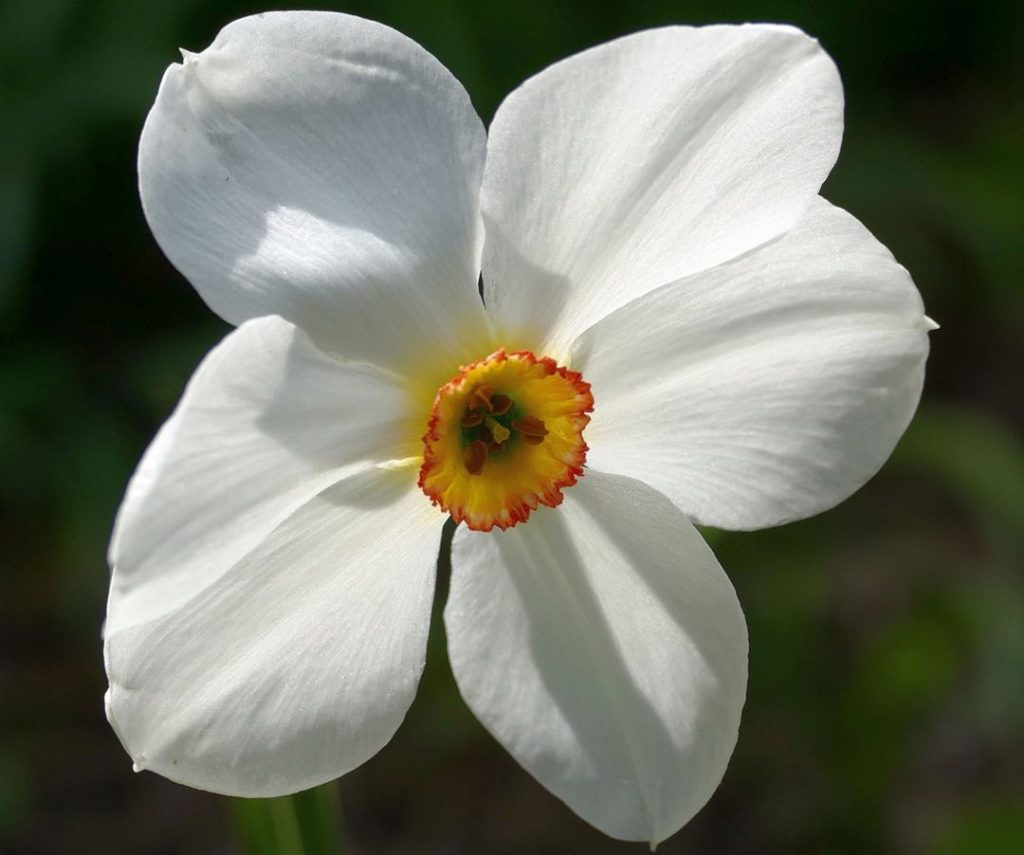
Andorra
Grandalla
Narcissus poeticus

General Description / Cultural Significance
One of the most widely dispersed wild plants in Andorra, the highly fragrant Grandalla, Narcissus poeticus, blooms year after year, April through June with their face following the sun as their powerful aroma scents mountains and meadows of the Pyrenean region. The native flower has a yellow corona with a red hued rim, surrounded by a ring of white petals. A single flower sits on a leafless hollow stem that grow 30.48-35.56 centimeters (12-14 inches) tall and are surrounded by long green leaves. It is known as the narcissus of ancient times and it is the country’s national flower. Grandella is a very important plant in maintaining the country’s biodiversity by signaling pollinators insects, especially bees.
Climate Change / Conservation Status
Tourism is one of the Andorra’s primary sources of income, and millions visit each year for what has traditionally been a long ski season. There has been a reduction in glacier mass and a change in the quantity and frequency of snowfall caused by an increase in temperatures due to climate change. It is a situation that affects all levels of biodiversity of the mountain ecosystem. The area has become very vulnerable, and there does not seem to be a way to compensate for the changes, which will have both short- and long-term financial impact. The conditions have been exacerbated by coal burning power plants in Andorra. Locations below 1,524 meters (5,000 feet) are currently the most affected, reducing air quality and concentrating greenhouse gases in the country’s valleys.,
Andorra is located in the Pyrenees mountains and is extremely vulnerable to climate change. The rapid melting of the glaciers and changes in the frequency of snowfall is a challenge to the mountain ecosystem and its biodiversity. Yet, the country has minimal climate change initiatives and is not a part of the Kyoto Protocol.
However, Narcissus poeticus was one of the fist species of the Narcissus genus to be cultivated and because of its adaptability, it is one of the most popular ornamental plants worldwide. Narcissus poeticus is also highly cultivated outside Andorra for many reasons. The aromatic extracted from the flower is used in perfumery and aromatherapy and its compounds, especially its alkaloids, are used the pharmaceutical industry. The alkaloid galantamine is cognition enhancing, and is used in medication to treat dementia.
Even though the plant is cultivated and hybridized, in the wild Narcissus poeticus is under threat of habitat destruction, climate change and the unsustainable collecting of wild bulbs. Already, the ICUN considers 5 species of Narcissus to be endangered, and others to be extinct in the wild.
Alternate Names
Grandalla
Findern flower
Poet’s daffodil
Poet’s narcissus
Nargis
Pheasant’s eye
Pinkster lily
Sources
Permanent Mission of the Principality of Andorra to the United Nations. This statement can be found on the World Sensorium original website.
Philander, S. G., 2012. Encyclopedia of Global Warming and Climate Change. SAGE Publications, Inc. [website] ISBN: 9781412992619
Science Daily, 2013. Climate change could cause massive losses in Pyrenees ski resorts. ScienceDaily. [website]
what-when-how, 2019. Andorra (Global Warming). what-when-how. [website]

